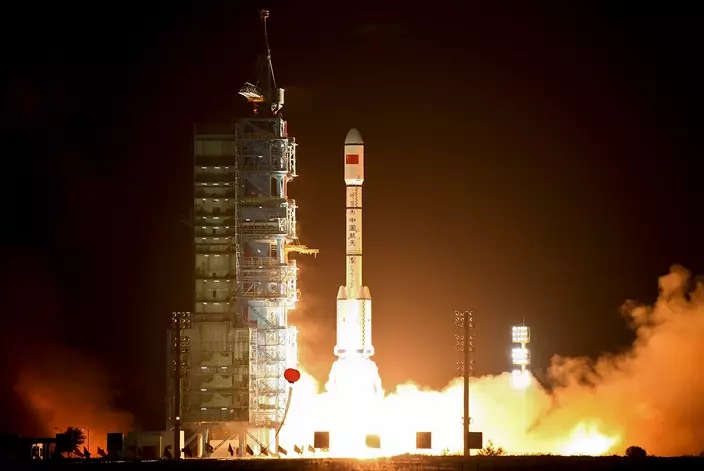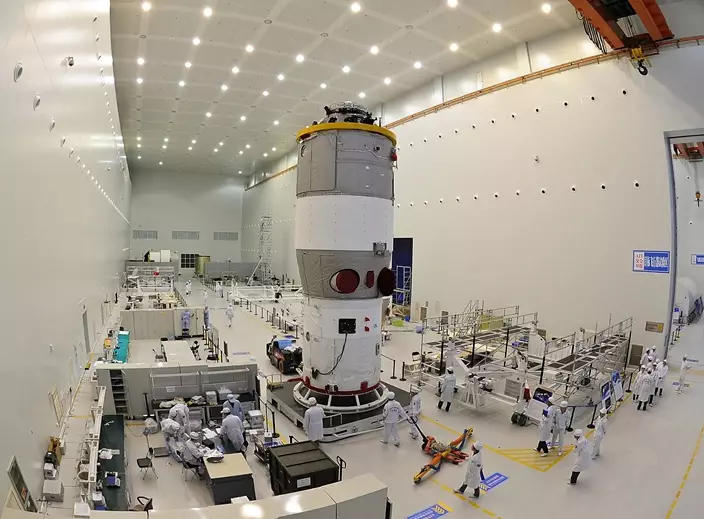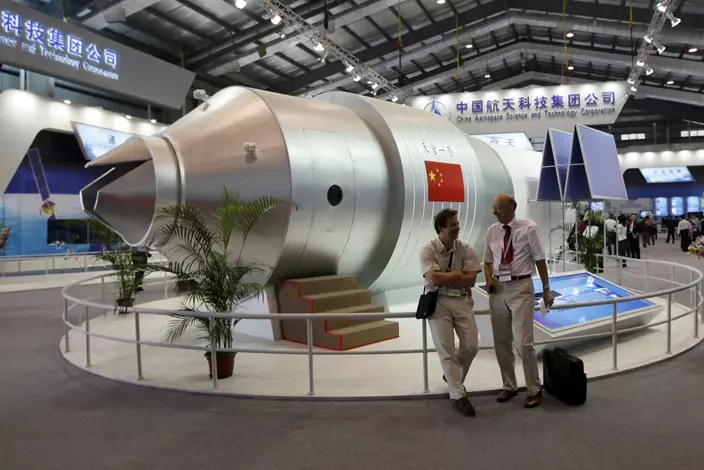China's defunct and reportedly out-of-control Tiangong 1 space station is expected to re-enter Earth's atmosphere sometime this weekend. It poses only a slight risk to people and property on the ground, since most of the bus-size, 8.5-ton vehicle is expected to burn up on re-entry, although space agencies don't know exactly when or where that will happen.

In this Sept. 29, 2011, file photo, a Long March-2FT1 carrier rocket loaded with China's Tiangong-1 space station blasts off from the launch pad at the Jiuquan Satellite Launch Center in northwest China's Gansu Province. (Color China Photo via AP, File)
Below are some questions and answers about the station, its re-entry and the past and future of China's ambitious space program.
Click to Gallery
China's defunct and reportedly out-of-control Tiangong 1 space station is expected to re-enter Earth's atmosphere sometime this weekend. It poses only a slight risk to people and property on the ground, since most of the bus-size, 8.5-ton vehicle is expected to burn up on re-entry, although space agencies don't know exactly when or where that will happen.
Below are some questions and answers about the station, its re-entry and the past and future of China's ambitious space program.
Western space experts say they believe China has lost control of the station. China's chief space laboratory designer Zhu Zongpeng has denied Tiangong was out of control, but hasn't provided specifics on what, if anything, China is doing to guide the craft's re-entry.
Based on its size, only about 10 percent of the spacecraft will likely survive being burned up on re-entry, mainly its heavier components such as its engines. The chances of anyone person on Earth being hit by debris is considered less than one in a trillion.
Ren Guoqiang, China's defense ministry spokesman, told reporters Thursday that Beijing has been briefing the United Nations and the international community about Tiangong 1's re-entry through multiple channels.
The breakup on re-entry of the Columbia space shuttle in 2003 killed all seven astronauts and sent more than 80,000 pieces of debris raining down on a large swath of the Southern United States. No one on the ground was injured.
___
WHAT WILL HAPPEN AND HOW GREAT IS THE DANGER?
The European Space Agency predicts the station will re-enter the atmosphere between Saturday morning and Sunday afternoon — an estimate it calls "highly variable," likely because the ever-changing shape of the upper atmosphere affects the speed of objects falling into it.
The Chinese space agency's latest estimate puts re-entry between Saturday and Wednesday.

In this June 18, 2012, file image released by China's Xinhua News Agency, Chinese astronauts, from left, Liu Wang, Liu Yang and Jing Haipeng wave while aboard the orbiting Tiangong-1 space station. (Beijing Aerospace Control Center/Xinhua via AP)
Western space experts say they believe China has lost control of the station. China's chief space laboratory designer Zhu Zongpeng has denied Tiangong was out of control, but hasn't provided specifics on what, if anything, China is doing to guide the craft's re-entry.
Based on Tiangong 1's orbit, it will come to Earth somewhere between latitudes of 43 degrees north and 43 degrees south, or roughly somewhere over most of the United States, China, Africa, southern Europe, Australia and South America. Out of range are Russia, Canada and northern Europe.

In this June 13, 2013, file image released by China's Xinhua News Agency, the Shenzhou-10 manned spacecraft is seen while conducting docking with the orbiting Tiangong-1 space module. (Beijing Aerospace Control Center/Xinhua via AP, File)
Based on its size, only about 10 percent of the spacecraft will likely survive being burned up on re-entry, mainly its heavier components such as its engines. The chances of anyone person on Earth being hit by debris is considered less than one in a trillion.

This undated file photo shows researchers testing China's first space station module Tiangong-1 at the Jiuquan Satellite Launch Center in northwest China's Gansu Province prior to its launch on Sept. 29, 2011. (Color China Photo via AP, File)
Ren Guoqiang, China's defense ministry spokesman, told reporters Thursday that Beijing has been briefing the United Nations and the international community about Tiangong 1's re-entry through multiple channels.
___
HOW COMMON IS MAN-MADE SPACE DEBRIS?
Debris from satellites, space launches and the International Space Station enters the atmosphere every few months, but only one person is known to have been hit by any of it: American woman Lottie Williams, who was struck but not injured by a falling piece of a U.S. Delta II rocket while exercising in an Oklahoma park in 1997.
Most famously, America's 77-ton Skylab crashed through the atmosphere in 1979, spreading pieces of wreckage near the southwestern Australia city of Perth, which fined the U.S. $400 for littering.

This undated file photo shows researchers installing China's first space station module Tiangong-1 at the Jiuquan Satellite Launch Center in northwest China's Gansu Province prior to its launch on Sept. 29, 2011. (Color China Photo via AP, File)
The breakup on re-entry of the Columbia space shuttle in 2003 killed all seven astronauts and sent more than 80,000 pieces of debris raining down on a large swath of the Southern United States. No one on the ground was injured.
In 2011, NASA's Upper Atmosphere Research Satellite was considered to pose a slight risk to the public when it came down to Earth 20 years after its launching. Debris from the 6-ton satellite ended up falling into the Pacific Ocean, causing no damage.

In this Nov. 16, 2010 file photo, visitors sit beside a model of China's Tiangong-1 space station at the 8th China International Aviation and Aerospace Exhibition in Zhuhai in southern China's Guangdong Province. (AP Photo/Kin Cheung, File)
China's own space program raised major concerns after it used a missile to destroy an out-of-service Chinese satellite in 2007, creating a large and potentially dangerous cloud of debris.
___
WHAT IS TIANGONG 1 AND WHAT WAS IT USED FOR?
Launched in 2011, Tiangong 1 was China's first space station, serving as an experimental platform for bigger projects such as the Tiangong 2 launched in September 2016 and a future permanent Chinese space station.
The station, whose name translates as "Heavenly Palace," played host to two crewed missions that included China's first female astronauts and served as a test platform for perfecting docking procedures and other operations. Its last crew departed in 2013 and contact with it was cut in 2016. Since then it has been orbiting gradually closer and closer to Earth on its own while being monitored.
The station had two modules, one for its solar panels and engines, and one for a pair of astronauts to live in and conduct experiments. A third astronaut slept in the Shenzhou spaceships that docked with the station, which also contained facilities for personal hygiene and food preparation.
___
HOW ADVANCED IS CHINA'S SPACE PROGRAM?
Since China conducted its first crewed mission in 2003 — becoming only the third country after Russia and the U.S. to do so — it has taken on increasingly ambitious projects, including staging a spacewalk and landing its Jade Rabbit rover on the moon.
China now operates the Tiangong 2 precursor space station facility, while the permanent station's 20-ton core module is due to be launched this year. The completed 60-ton station is set to come into full service in 2022 and operate for at least a decade.
China was excluded from the 420-ton International Space Station mainly due to U.S. legislation barring such cooperation and concerns over the Chinese space program's strong military connections. China's space program remains highly secretive and some experts have complained that a lack of information about Tiangong 1's design has made it harder to predict what might happen upon its re-entry.
A mission to land another rover on Mars and bring back samples is set to launch in 2020. China also plans to become the first country to soft-land a probe on the far side of the moon.
OTTAWA, Ontario--(BUSINESS WIRE)--May 1, 2024--
As May marks Vision Health Month, the Canadian Association of Optometrists (CAO) releases a digital national campaign to raise public awareness about eye health and vision care, encouraging Canadians to get their eyes checked. Several provincial associations of optometrists ( New Brunswick Association of Optometrists, Newfoundland & Labrador Association of Optometrists, Nova Scotia Association of Optometrists, and The Prince Edward Island Association of Optometrists ) and sponsors from the industry - Alcon, CooperVision, and Sun Pharma - joined and supported this campaign.
This press release features multimedia. View the full release here: https://www.businesswire.com/news/home/20240501239056/en/
Urgent need for public education about eye health and vision care
8+ million Canadians are at risk of eye-threatening conditions, yet 75% of vision loss can be treated or prevented if diagnosed early. Despite Canadians highly valuing their eyesight and fearing its loss, there is a prevalent lack of awareness regarding the necessity of regular, comprehensive eye exams. Many individuals often overlook the importance of thorough examinations for early detection.
A 2022 survey 1 revealed a telling statistic: 37% of respondents who had not seen an eye care professional in over two years did so because they believed there was nothing wrong with their vision. Additionally, the survey found that men in Canada are less likely than women to prioritize eye health.
With those statistics in mind, the CAO released a new digital campaign to raise public awareness about eye health and vision through a simple yet potent message: “GetEyeWise!”
“Many serious eye conditions do not present obvious symptoms initially. Waiting for symptoms to appear can expose individuals to significant risks, particularly within an aging population, those engaging in increased near-work, and amidst a myopia epidemic among children. Integrating eye care into the healthcare routines of all age groups, from toddlers to seniors, is crucial, ” says Dr. Martin Spiro, President of the Canadian Association of Optometrists.
Think of an eye exam as a physical for your eyes…and more
A comprehensive eye examination is the best tool for the early detection of eye disease and several systemic diseases. It is based on the premise that structural change in the eye (often at the microscopic level) manifests itself well before any functional changes and vision loss occur.
Optometrists diagnose, treat, and help prevent diseases and disorders affecting the visual system (the eye and related structures).
They also assist in identifying general health conditions like stroke, cardiovascular diseases, diabetes, hypertension, some cancers, brain injuries, and neurological conditions that are often first detected through a comprehensive eye exam. They provide referrals to specialists and can help manage post-eye-surgery health. From infants to seniors, optometrists provide care to help maintain good vision, eye health and quality of life.
The Canadian Association of Optometrists developed evidence-based guidelines for Recommended Frequency of the Comprehensive Eye Examination and calls on all Canadians to “GetEyeWise.”
“If grownups think their eyes are fine…then why are they always doing things like this?”
The national campaign features children mimicking adults’ faces in daily situations to encourage everyone to “GetEyeWise” and book an appointment with an optometrist. It will run throughout May on Facebook, Instagram, YouTube, TikTok, and Spotify in both official languages.
“Together with the Canadian Association of Optometrists, we are dedicated to raising awareness of the importance of regular eye exams and to helping people see brilliantly,” said Vanessa Johari Hansen, Country Business Unit Head, Vision Care, at Alcon Canada. “Too often, eye exams are neglected, but through our partnership, we're determined to enhance vision and improve eye health, recognizing their vital role in overall well-being."
To find more about the CAO campaign, please visit: https://opto.ca/geteyewise
About the Canadian Association of Optometrists
The Canadian Association of Optometrists (CAO) is the national voice of optometry and is dedicated to providing leadership and support to its 8,300+ members to enhance the delivery of healthy eyes and clear vision for all Canadians. For more information, visit www.opto.ca
About Alcon
Alcon helps people see brilliantly. As the global leader in eye care with a heritage spanning over 75 years, we offer the broadest portfolio of products to enhance sight and improve people’s lives. Our Surgical and Vision Care products touch the lives of more than 260 million people in over 140 countries each year living with conditions like cataracts, glaucoma, retinal diseases and refractive errors. Our more than 25,000 associates are enhancing the quality of life through innovative products, partnerships with Eye Care Professionals and programs that advance access to quality eye care. Learn more at www.alcon.ca
About CooperVision
CooperVision, a division of CooperCompanies (NYSE:COO), is one of the world’s leading manufacturers of contact lenses. The company produces a full array of daily disposable, two-week and monthly soft contact lenses that feature advanced materials and optics, and premium rigid gas permeable lenses for orthokeratology and scleral designs. CooperVision has a strong heritage of addressing the toughest vision challenges such as astigmatism, presbyopia, childhood myopia, and highly irregular corneas; and offers the most complete portfolio of spherical, toric and multifocal products available. Through a combination of innovative products and focused practitioner support, the company brings a refreshing perspective to the marketplace, creating real advantages for customers and wearers. For more information, visit https://coopervision.ca
About Sun Pharma
Sun Pharma entered the Canadian market in 2015 with the purchase of Ranbaxy Laboratories Limited, a Top 10 generic company in Canada since 2005. Sun Pharma is a world leader in branded and generic drugs and we are now well positioned to be an even larger contributor to the Canadian healthcare landscape.
With global manufacturing across six continents, we are investing in Canada by bringing high quality, affordable and innovative medicines to market. Our global strength in R&D with an unwavering commitment to quality ensures Sun Pharma will offer a wide range of affordable medicines for Canadians.
Taro Pharmaceuticals is the exclusive distributor of our specialty and generic products in Canada.
We feel the strength of our global Sun Pharma capabilities together with Taro Pharmaceutical’s 30-year commitment to Canadian manufacturing and distribution creates a unique pharmaceutical partner for our Canadian customers. It is our continued goal to provide our customers and partners with high quality products and exceptional customer service.
We look forward to many more years of providing Canadians with high quality and affordable medicines. To learn more, visit: https://sunpharma.com/canada-branded-products/


The Canadian Association of Optometrists Releases a New “GetEyeWise” Digital Campaign to Bring Awareness About Eye Health and Vision Care
















